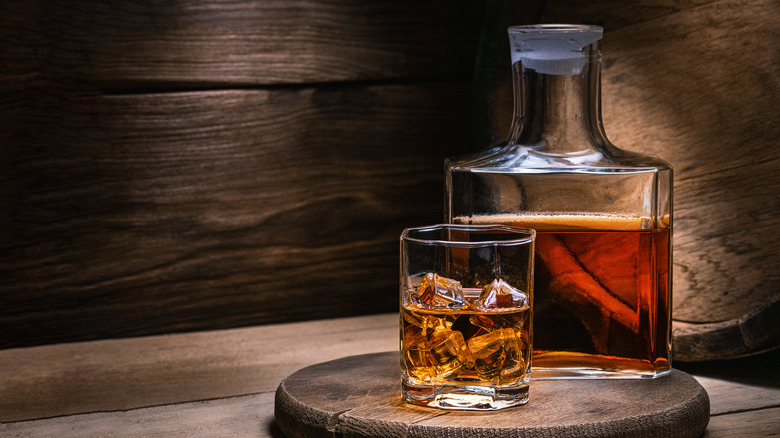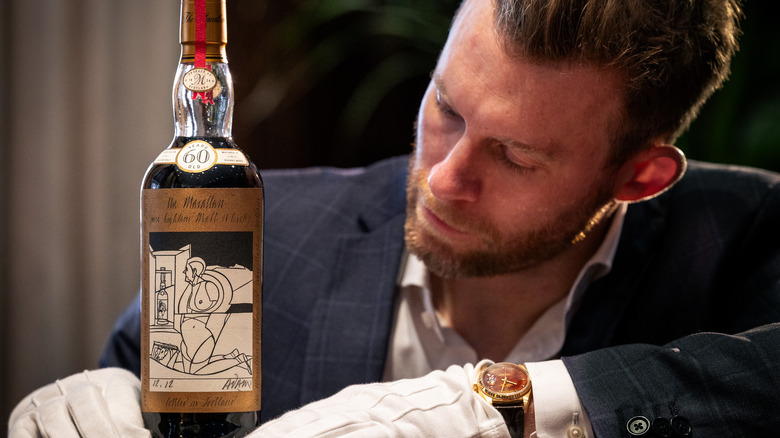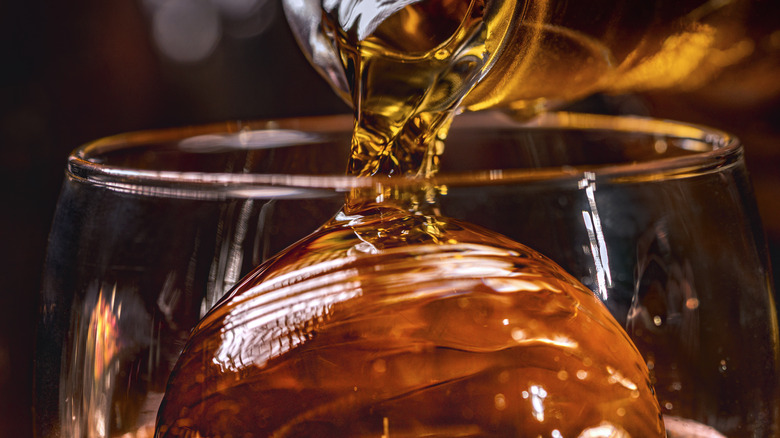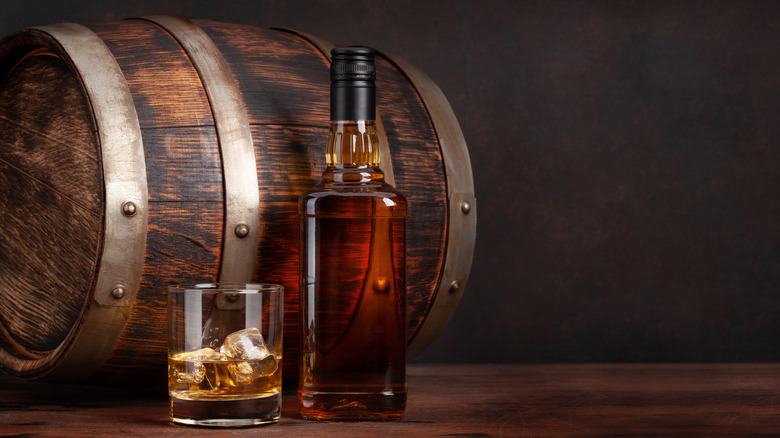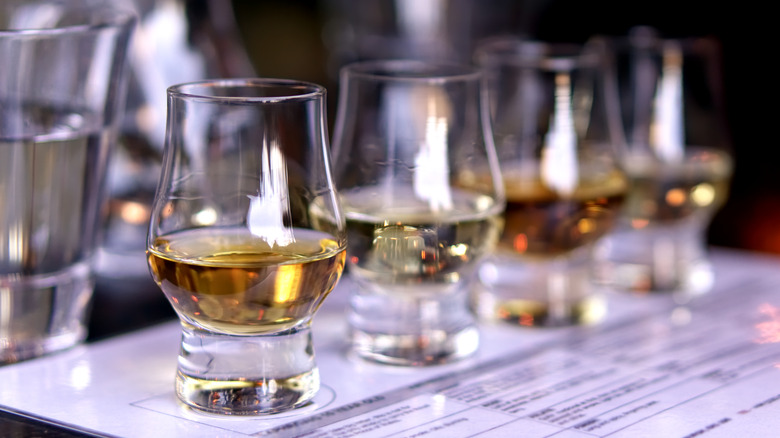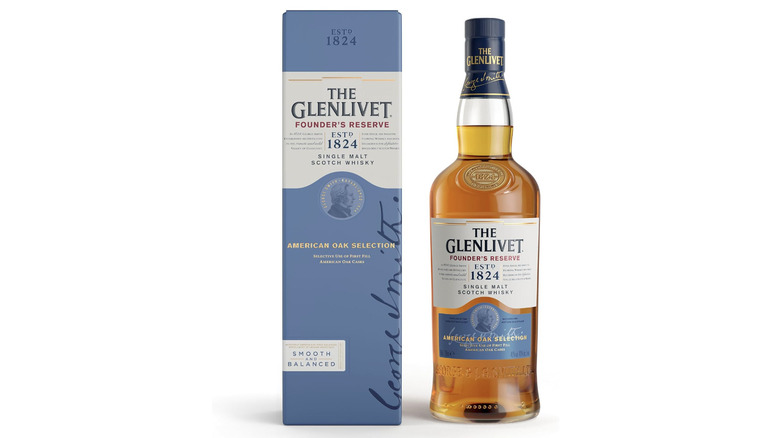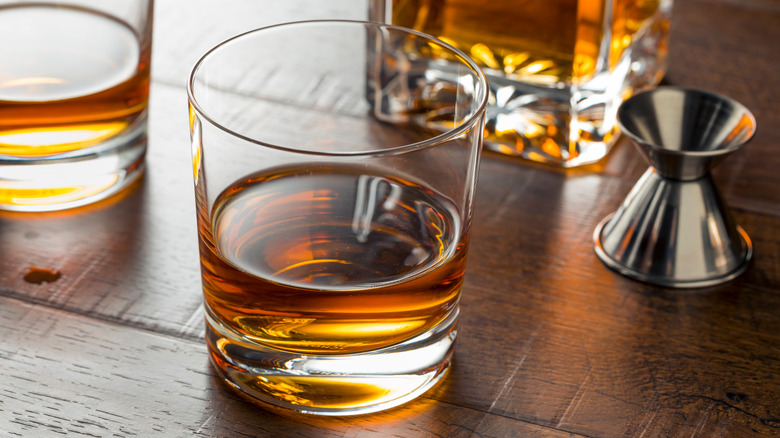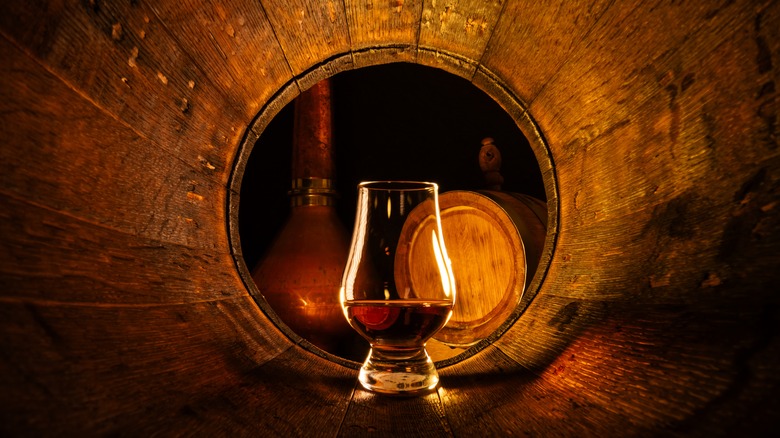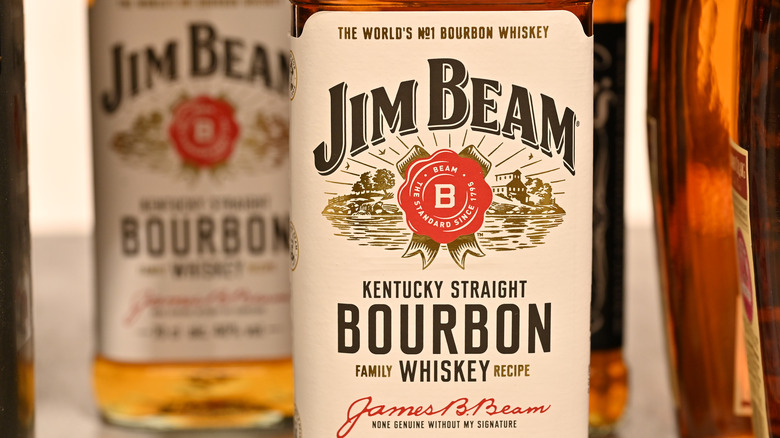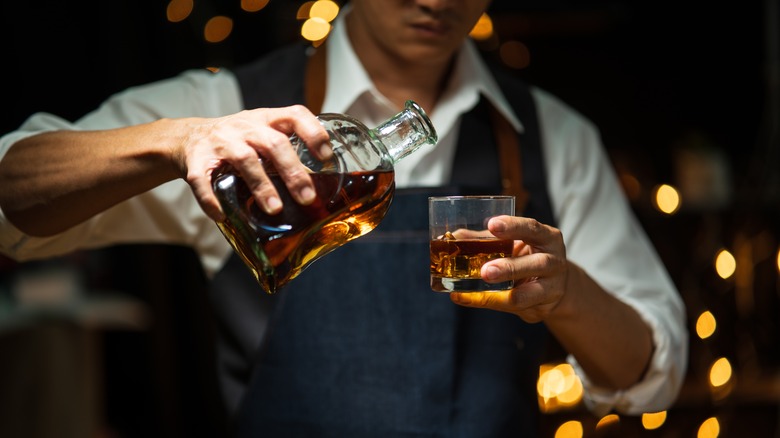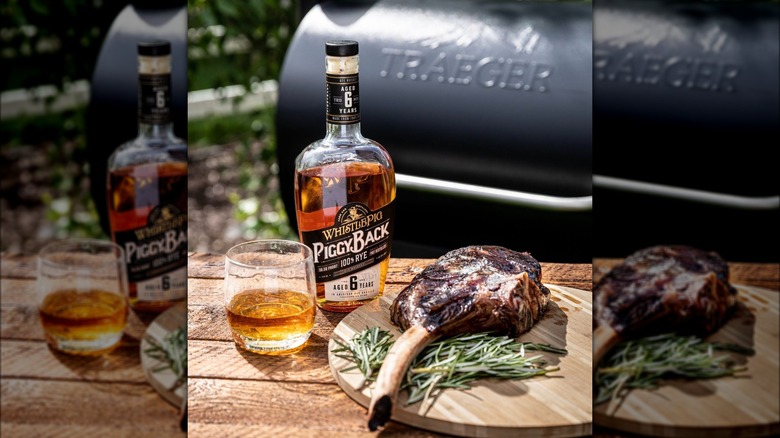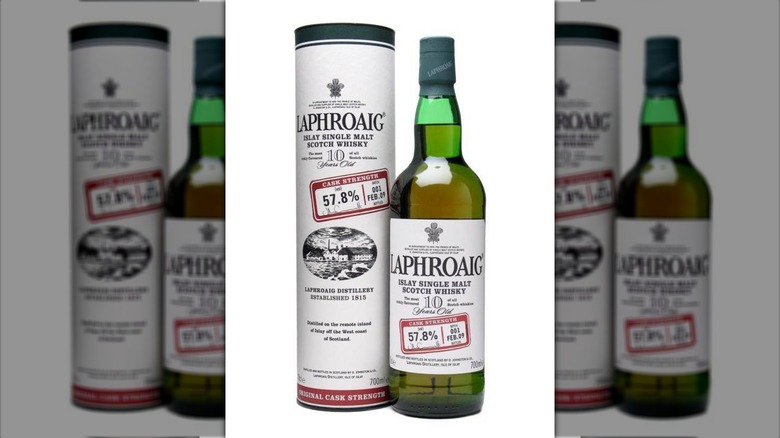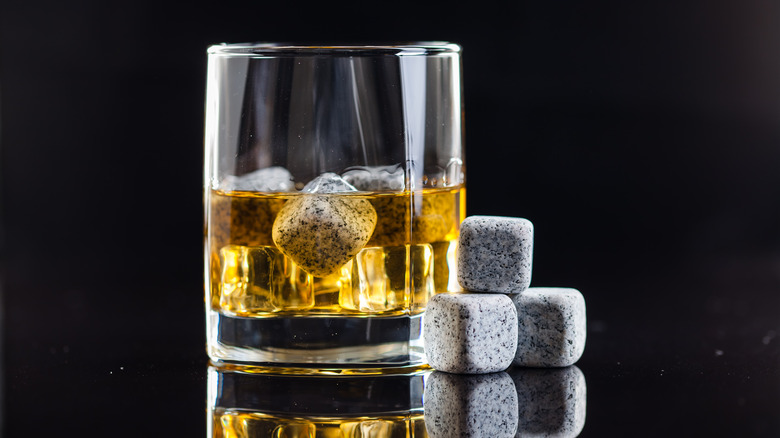False Facts About Whiskey You Thought Were True
Cherished for its complexity and depth, whiskey holds a special place in the hearts of both casual sippers and seasoned experts. Whether it's an Irish whiskey, an American bourbon or rye, or even a distinguished Scotch or Japanese whisky — the spelling largely depends on the spirit's place of origin — each variety boasts its own unique story and flavor profile. The spirit's versatility also shines in the many ways that it can be savored. Enjoyed neat, on the rocks, or as the base of classic and modern cocktails, appeals to a broad spectrum of tastes and preferences.
The distillation process, which is central to the production of whiskey, was first developed in the region of modern-day Iraq and Syria some 4,000 years ago. However, it took approximately 3,000 years for distillation to make its way to Scotland and Ireland, where whiskey production as we know it began to take shape. The history of American whiskey began in the late 18th century when Scottish and Irish immigrants brought their distilling methods to the growing nation. They began brewing the spirit with rye and later corn, leading to the creation of distinctive American whiskey styles, such as bourbon and Tennessee whiskey.
Today, whiskey is celebrated as one of the most popular spirits in the world. However, despite this, the amber liquor remains veiled in misconceptions. Ready to separate the real from the imaginary? Keep reading!
False: Older whiskeys are always better
The misconception that aged whiskeys are superior to their younger counterparts stems mainly from the perceived rarity and therefore the value of older bottles. While it's true that the maturation process in oak barrels can enhance whiskey's characteristics, infusing it with a variety of wood-based flavors like pepper, vanilla, and caramel, age alone doesn't determine the quality of whiskey. Instead, that depends more on individual taste preferences.
Moreover, there's a point in the aging process where whiskey is most likely to reach its optimal complexity, meaning that aging the tipple beyond that can lead to an overly woody profile. While there's no optimal aging time for this spirit, as a rule of thumb, the process depends on a variety of factors that include whiskey type, the variety of barrels used for aging, and the climate where they are stored.
Broadly speaking, the best aging time for bourbon is between five and 12 years. For Scotch, that's more typically between 12 and 25 years. After this time, the whiskies are likely to become bitter and unpleasantly oaky. Despite this, some whiskey enthusiasts aren't deterred from older bottles, as a single 60-year-old bottle of Macallan Adami 1926 fetched a cool $2.7 million at a 2023 auction.
False: The color of whiskey indicates its age
As whiskey matures in wooden barrels, it undergoes a transformation that can deepen its color, flavor, and aroma. This process leads some to assume that the older the whiskey, the deeper its hue since it has spent more time absorbing the characteristics of wood. While it's true that whiskey generally darkens over time due to prolonged interaction with the wooden casks during aging, this is not a foolproof method of estimating its age.
In reality, whiskeys aged for the same amount of time can exhibit significant color variations. This is because whiskey's color can be affected by the type of cask used and whether it's subjected to charring, as well as the temperature and humidity of the warehouse where it's stored and the composition of the spirit's original mash bill. For instance, American white oak is likely to turn the spirit a red color, while European oak is more apt to give it a yellowish hue. Additionally, whiskey aged in new oak barrels typically exhibits a darker color than that those spirits aged in used barrels. Another practice that further complicates the correlation between whiskey's color and age is that some distilleries add caramel coloring to achieve color consistency between batches.
False: Whiskey has to be expensive to be good
There's a common belief that the price of whiskey reflects its quality. While this can be true, it's not always the case. Many factors contribute to the cost of whiskey, including the aging process, scarcity, and branding, rather than the quality of the spirit alone. Pricier whiskeys are often aged longer, which is thought to enhance their flavor profile. This extended storage time and the greater loss of volume to evaporation, known as the angel's share, increases the drop's price point. In addition, whiskey can be more expensive simply because it comes from a renowned distillery with a storied history.
Apart from the subjective nature of your whiskey preference, the emergence of craft distilleries has expanded our choices even further when it comes to affordable whiskeys. According to the American Distilling Institute, there were 2,283 craft distillers in the U.S. in 2022, a huge growth from just 75 distillers in 2006. Many of these smaller producers are exploring new grain types, distilling methods, and aging processes. As a result, their whiskeys are challenging the status quo of high-end brands by providing whiskey lovers with quality choices that don't always come with hefty price tags.
False: All whiskey tastes the same
Casual drinkers, who may not take the time to explore the flavors and aromas of whiskey, may sometimes say that all whiskey tastes the same. This isn't surprising. The range of whiskey types and the nuances within each category often require a certain level of commitment and expertise to fully appreciate, which not every whiskey enthusiast may possess. But those nuances do mean there can be significant differences when one whiskey is compared to another.
There's a wide array of factors that can influence the flavor profile of whiskey. Firstly, the type of grain used to produce whiskey can impart it with a distinct flavor. For instance, Scotch gets its characteristic taste from malted barley, while the U.S. government says that a bourbon's mashbill must contain 51% corn to maintain its distinctive character. Various quantities of other grains like rye, wheat, and oats are also utilized in the production of whiskey.
Secondly, the source of water, a key element of whiskey production, can affect the final flavor of the sip due to its mineral content. Additionally, the distillation process, including the length of time the spirit spends aging and the environment it's in during that process, is also crucial to determining the flavor nuances of the final product.
False: Single malt whiskey is always better than blended whiskey
Crafted exclusively from malted barley and aged in barrels for a minimum of three years, single malt whiskey originates from one distillery. As such, it offers a distinct flavor that reflects its specific point of origin and production techniques. That said, even single malt whiskey usually contains a blend of various malted barley whiskey batches from the same distillery. In contrast, blended whiskey combines different types of whiskey from multiple distilleries, often using a mixture of grains such as corn, rye, and wheat.
While purists swear that single malt whiskey is superior to its blended counterpart, the reality isn't quite so simple. The truth is that blended whiskey is often more balanced than single malt whiskey because distillers who undertake the blending process aim to create a whiskey that appeals to a wider range of palates. As a result, blended whiskey is usually smooth enough to drink on the rocks or even neat. Being more affordable than single malts, it's also ideal for mixing into cocktails.
False: Whiskey should always be drunk neat
According to some connoisseurs, sipping whiskey neat is the only way to appreciate its unique characteristics. For the uninitiated, drinking a spirit neat refers to enjoying it in its unadulterated state, free from water, ice, or any mixers. Neat pours are usually served at room temperature to allow the drinker to experience the tipple's full flavor, texture, and aroma.
While savoring whiskey neat offers the opportunity to experience the spirit's pure taste and subtle notes, it is by no means the only way to enjoy this barrel-aged spirit. For instance, many argue that adding a little water to whiskey can enhance its flavors and render it more accessible for newbies or those who dislike the strong taste of alcohol. Whiskey on the rocks presents another — and perhaps more refreshing — approach, as the drink is served with ice. This way of drinking the spirit is perfect for those who enjoy the flavor changes that accompany the gradual dilution of the spirit as the ice melts.
Whiskey also makes a great addition to classic cocktails, such as the mint julep and the Manhattan, as blending the spirit with other ingredients can enhance both the flavor and aroma of the beverage.
False: Whiskey never goes bad
Some people believe that whiskey never expires due to its relatively high alcohol content. Indeed, whiskey has an alcohol concentration of at least 40% ABV, which can act as a preservative, inhibiting the growth of bacteria that can lead to spoilage. While unopened bottles of high-quality whiskey can technically last for many decades, there are many variables that can affect the spirit's shelf life.
The lifespan of unopened whiskey depends on several factors, including the type of whiskey being stored. For example, a sealed bottle of bourbon will likely last longer than an unopened bottle of Scotch because it has a higher alcohol content. When it comes to whiskey going the distance, storage conditions are also key. Ideally, whiskey should be kept in a cool, dark place away from sunlight. Nevertheless, it's important to remember that no matter the quality and how well it's stored, unopened whiskey will degrade over time.
Opening a bottle of whiskey exposes it to oxygen, which immediately starts to alter its taste profile. However, the rate of this change can vary depending on factors like whiskey type and storage conditions. To extend the lifespan of an opened bottle of whiskey, limit its exposure to air, sealing the bottle tightly after each pour and keeping it in a cool, dark area. As whiskey oxidizes faster with less volume in the bottle, it's best to decant it into a smaller flask once you've consumed more than half of the bottle.
False: Bourbon has to be made in Kentucky
Kentucky is all but synonymous with bourbon. There's even a popular Kentucky Bourbon Trail that offers whiskey enthusiasts an opportunity to sample pours from some of the state's most renowned distilleries. Kentucky has been a producer of bourbon since settlers in the region started distilling corn-based whiskey in the late 18th century. Over time, the state has retained its number one status as a bourbon producer due to several factors such as its limestone-rich water and abundance of corn, a key ingredient in bourbon mash bills. However, bourbon can be made elsewhere.
Although bourbon production is legally permitted anywhere in the United States, the liquor has to meet several specific criteria to earn its label. The federal Alcohol and Tobacco Tax and Trade Bureau defines bourbon in the following terms: "Whisky produced in the U.S. at not exceeding 80% alcohol by volume (160 proof) from a fermented mash of not less than 51 percent corn and stored at not more than 62.5% alcohol by volume (125 proof) in charred new oak containers." Even though bourbon can be produced outside Kentucky, the state's deep-rooted bourbon history and culture have led to the widespread misconception that it can't be produced anywhere else.
False: Whiskey doesn't freeze
Don't be taken aback if you place your whiskey in the freezer and find, much later, that it hasn't even formed any ice crystals. This is perfectly normal. However, just because whiskey doesn't freeze in your kitchen, doesn't mean that it won't freeze under the right circumstances.
Whiskey has a low freezing point. Unlike water, which freezes at 32 degrees Fahrenheit, whiskey requires much colder conditions to solidify, at approximately -17 degrees Fahrenheit, though that's contingent on a particular spirit's alcohol concentration. Since a standard home freezer hovers around 0 degrees Fahrenheit, it's simply not up to the job. If mixed with water, however, whiskey can take on the appearance of slush due to its lowered freezing point.
While chilled whiskey can be a treat, many maintain that it's better to drink it on the rocks rather than keep it at the ready in a home freezer. This is because cooling the spirit in the freezer can mute its flavors and aromas. Additionally, freezing whiskey can alter its viscosity, causing it to become overly thick. To fully appreciate the nuances of a fine whiskey, it's generally best to store it at room temperature or just below it rather than subject the bottle to freezing conditions.
False: Whiskey can't be used in cooking
While it's common to hear about people cooking with wine or beer, whiskey is often overlooked as an ingredient in recipes. The exact reason for this oversight is unclear, but it could have something to do with the spirit's strong and distinct flavor profile. Indeed, adding too much whiskey to your dishes can overpower them. But, with a lighter hand, you'll find that incorporating a dash of whiskey into your epicurean creations can impart them with a unique twist. Best of all, you don't need to use an expensive bottle of whiskey to add a touch of complexity to your food.
From savory sauces to sweet desserts, a drizzle of whiskey can introduce a rich depth of flavor to dishes. The versatile spirit shines in a huge range of gastronomic applications. For instance, a delicate drizzle of whiskey over a steak just prior to grilling not only helps to potentially tenderize the meat but also infuses it with a unique smoky character. Moreover, whiskey can help build a more complex flavor profile in desserts like puddings and pie fillings, elevating them to new levels of indulgence. Finally, classic desserts like ice cream and chocolate can also benefit from a splash of the amber spirit.
False: The higher the proof, the better the whiskey
It's normal for whiskey to be diluted with water during the production process. While whiskey in the U.S. is never watered down below 80 proof, it's often much stronger than this. Cask-strength whiskey, also sometimes referred to as barrel-strength whiskey and high-proof whiskey, is a type of whiskey that's bottled directly from the barrel without dilution. This means that the whiskey retains the exact alcoholic strength it had when it was in the barrel, which frequently ranges from 100 to 140 proof, or even higher in some cases. Whiskey that exceeds this is colloquially referred to as "hazmat" and can't be taken on planes.
Many whiskey enthusiasts swear that high-proof whiskey boasts a richer and more complex flavor profile than its lower-proof counterparts. However, others are adamant that after a certain point, barrel-strength whiskey isn't all it's cracked up to be. As Jonah Flicker so eloquently puts it in Men's Journal, "I believe sipping a dram should be a mellow and pleasurable experience, not an exercise in masochism." While Flicker isn't against stronger whiskeys, he does say that anything over 130 proof is pushing the limits of good taste. Bourbon critic Chuck Cowdery agrees, telling Robb Report, "Nothing kills the taste buds like high-proof spirits. I won't criticize anyone for doing what they like, but don't kid yourself."
False: Whiskey stones are the best way to chill whiskey
Made from materials such as marble, granite, soapstone, and even stainless steel, whiskey stones come in a variety of shapes and sizes. While most whiskey stones resemble standard ice cubes, others come in circular shapes. The reusable stones are designed to chill spirits without watering them down as traditional ice cubes do. All you have to do is remember to pop them in the freezer a few hours before you indulge in your tipple.
So what's the issue with whiskey stones? The first common complaint is that they simply don't have the cooling power of standard ice cubes. Since they can only lower the drink temperature by a slight margin and for a short period of time, many find them inadequate. Moreover, the inability of whiskey stones to melt and gradually dilute the whiskey is also a letdown for some quaffers. Many whiskey enthusiasts believe that slight dilution helps release the flavors of the whiskey, making the beverage more nuanced and enjoyable. Last but not least, whiskey stones can scratch your high-quality whiskey glassware. Oh, the horror!
